Analyzing Social Media's Impact on Business Communication
VerifiedAdded on 2021/05/31
|11
|2675
|41
Essay
AI Summary
This essay examines the profound impact of social media on contemporary business communication. It explores the evolution from traditional methods to digital platforms, emphasizing how social media has transformed marketing, customer engagement, and brand loyalty. The study delves into the benefits of social media, such as expanding customer insights, improving brand awareness, running targeted ads, and creating more converting leads. It also addresses the challenges, including the need for strategic planning, potential risks like bullying and hacking, and the importance of continuous monitoring. The essay uses a clothing business case study to illustrate the practical application of social media in modern business operations and concludes by highlighting the need for proper controls to mitigate risks associated with social media use.
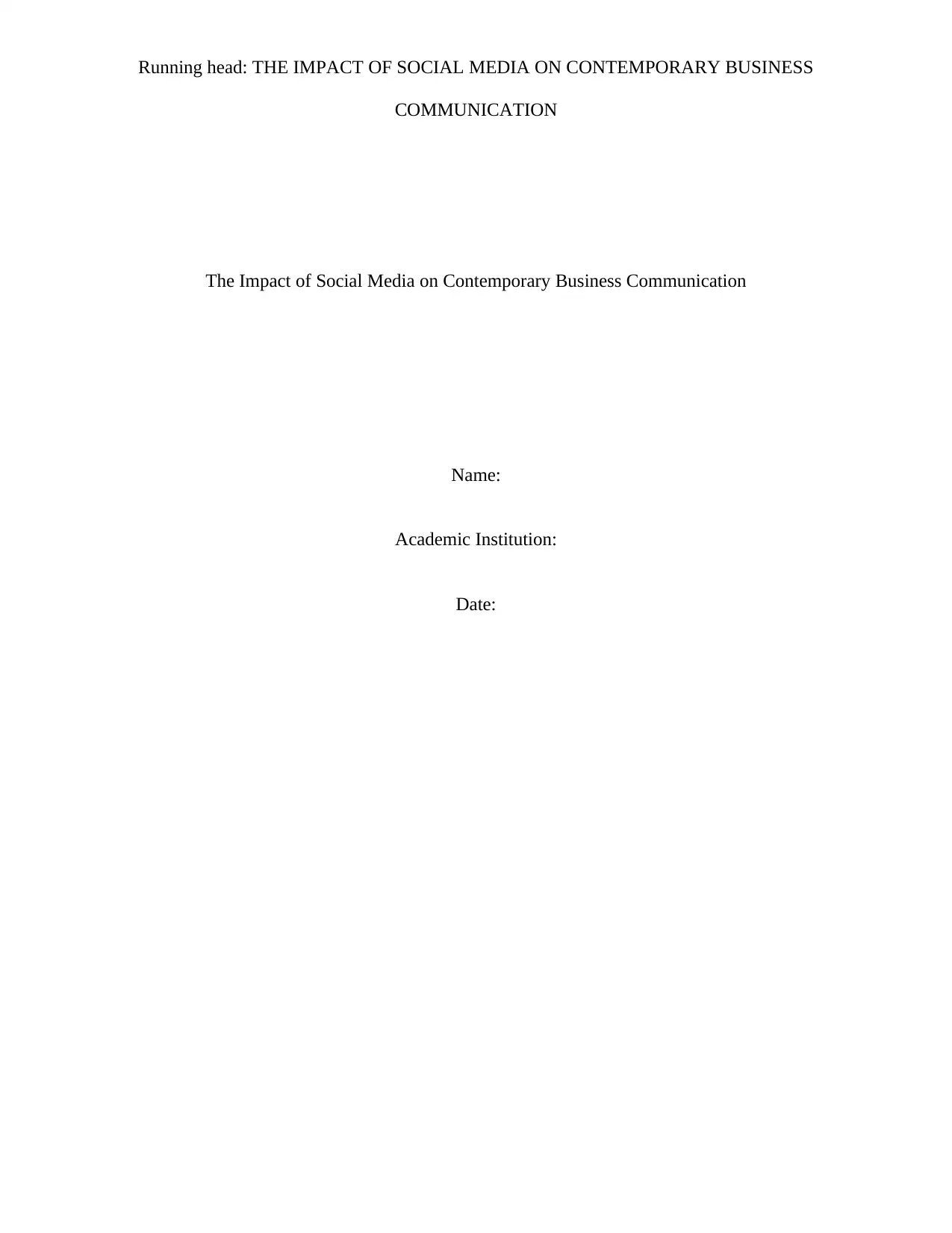
Running head: THE IMPACT OF SOCIAL MEDIA ON CONTEMPORARY BUSINESS
COMMUNICATION
The Impact of Social Media on Contemporary Business Communication
Name:
Academic Institution:
Date:
COMMUNICATION
The Impact of Social Media on Contemporary Business Communication
Name:
Academic Institution:
Date:
Paraphrase This Document
Need a fresh take? Get an instant paraphrase of this document with our AI Paraphraser
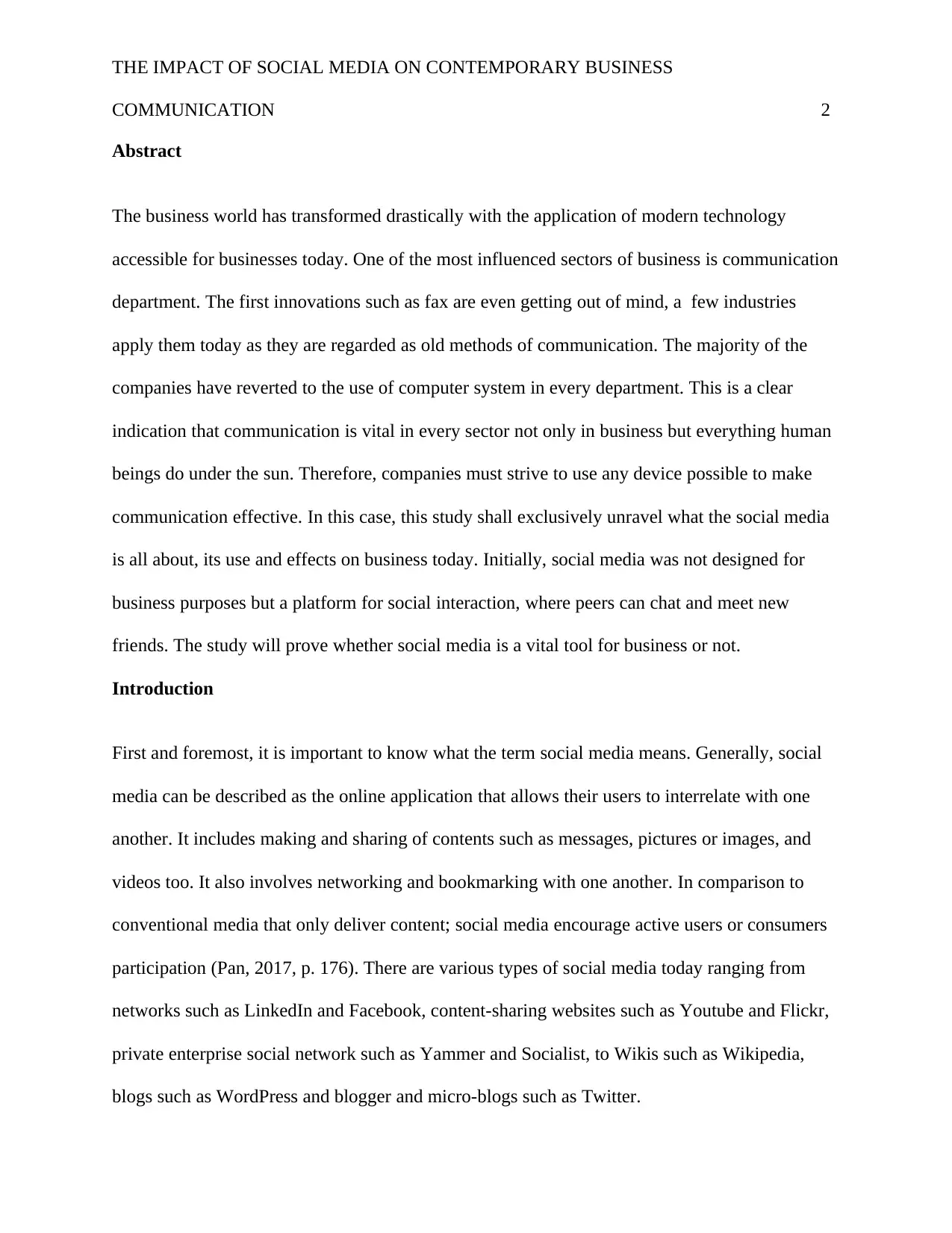
THE IMPACT OF SOCIAL MEDIA ON CONTEMPORARY BUSINESS
COMMUNICATION 2
Abstract
The business world has transformed drastically with the application of modern technology
accessible for businesses today. One of the most influenced sectors of business is communication
department. The first innovations such as fax are even getting out of mind, a few industries
apply them today as they are regarded as old methods of communication. The majority of the
companies have reverted to the use of computer system in every department. This is a clear
indication that communication is vital in every sector not only in business but everything human
beings do under the sun. Therefore, companies must strive to use any device possible to make
communication effective. In this case, this study shall exclusively unravel what the social media
is all about, its use and effects on business today. Initially, social media was not designed for
business purposes but a platform for social interaction, where peers can chat and meet new
friends. The study will prove whether social media is a vital tool for business or not.
Introduction
First and foremost, it is important to know what the term social media means. Generally, social
media can be described as the online application that allows their users to interrelate with one
another. It includes making and sharing of contents such as messages, pictures or images, and
videos too. It also involves networking and bookmarking with one another. In comparison to
conventional media that only deliver content; social media encourage active users or consumers
participation (Pan, 2017, p. 176). There are various types of social media today ranging from
networks such as LinkedIn and Facebook, content-sharing websites such as Youtube and Flickr,
private enterprise social network such as Yammer and Socialist, to Wikis such as Wikipedia,
blogs such as WordPress and blogger and micro-blogs such as Twitter.
COMMUNICATION 2
Abstract
The business world has transformed drastically with the application of modern technology
accessible for businesses today. One of the most influenced sectors of business is communication
department. The first innovations such as fax are even getting out of mind, a few industries
apply them today as they are regarded as old methods of communication. The majority of the
companies have reverted to the use of computer system in every department. This is a clear
indication that communication is vital in every sector not only in business but everything human
beings do under the sun. Therefore, companies must strive to use any device possible to make
communication effective. In this case, this study shall exclusively unravel what the social media
is all about, its use and effects on business today. Initially, social media was not designed for
business purposes but a platform for social interaction, where peers can chat and meet new
friends. The study will prove whether social media is a vital tool for business or not.
Introduction
First and foremost, it is important to know what the term social media means. Generally, social
media can be described as the online application that allows their users to interrelate with one
another. It includes making and sharing of contents such as messages, pictures or images, and
videos too. It also involves networking and bookmarking with one another. In comparison to
conventional media that only deliver content; social media encourage active users or consumers
participation (Pan, 2017, p. 176). There are various types of social media today ranging from
networks such as LinkedIn and Facebook, content-sharing websites such as Youtube and Flickr,
private enterprise social network such as Yammer and Socialist, to Wikis such as Wikipedia,
blogs such as WordPress and blogger and micro-blogs such as Twitter.
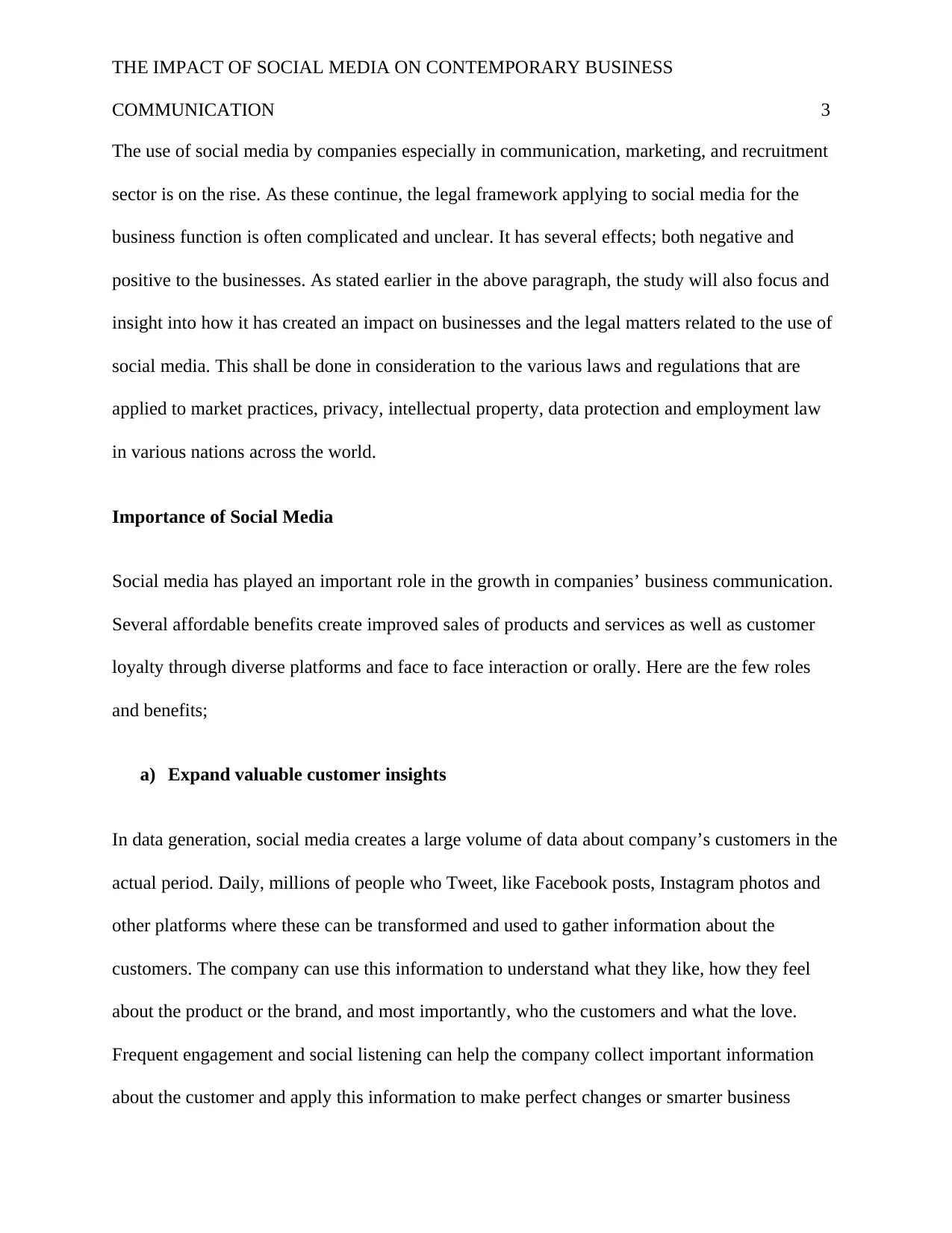
THE IMPACT OF SOCIAL MEDIA ON CONTEMPORARY BUSINESS
COMMUNICATION 3
The use of social media by companies especially in communication, marketing, and recruitment
sector is on the rise. As these continue, the legal framework applying to social media for the
business function is often complicated and unclear. It has several effects; both negative and
positive to the businesses. As stated earlier in the above paragraph, the study will also focus and
insight into how it has created an impact on businesses and the legal matters related to the use of
social media. This shall be done in consideration to the various laws and regulations that are
applied to market practices, privacy, intellectual property, data protection and employment law
in various nations across the world.
Importance of Social Media
Social media has played an important role in the growth in companies’ business communication.
Several affordable benefits create improved sales of products and services as well as customer
loyalty through diverse platforms and face to face interaction or orally. Here are the few roles
and benefits;
a) Expand valuable customer insights
In data generation, social media creates a large volume of data about company’s customers in the
actual period. Daily, millions of people who Tweet, like Facebook posts, Instagram photos and
other platforms where these can be transformed and used to gather information about the
customers. The company can use this information to understand what they like, how they feel
about the product or the brand, and most importantly, who the customers and what the love.
Frequent engagement and social listening can help the company collect important information
about the customer and apply this information to make perfect changes or smarter business
COMMUNICATION 3
The use of social media by companies especially in communication, marketing, and recruitment
sector is on the rise. As these continue, the legal framework applying to social media for the
business function is often complicated and unclear. It has several effects; both negative and
positive to the businesses. As stated earlier in the above paragraph, the study will also focus and
insight into how it has created an impact on businesses and the legal matters related to the use of
social media. This shall be done in consideration to the various laws and regulations that are
applied to market practices, privacy, intellectual property, data protection and employment law
in various nations across the world.
Importance of Social Media
Social media has played an important role in the growth in companies’ business communication.
Several affordable benefits create improved sales of products and services as well as customer
loyalty through diverse platforms and face to face interaction or orally. Here are the few roles
and benefits;
a) Expand valuable customer insights
In data generation, social media creates a large volume of data about company’s customers in the
actual period. Daily, millions of people who Tweet, like Facebook posts, Instagram photos and
other platforms where these can be transformed and used to gather information about the
customers. The company can use this information to understand what they like, how they feel
about the product or the brand, and most importantly, who the customers and what the love.
Frequent engagement and social listening can help the company collect important information
about the customer and apply this information to make perfect changes or smarter business
⊘ This is a preview!⊘
Do you want full access?
Subscribe today to unlock all pages.

Trusted by 1+ million students worldwide
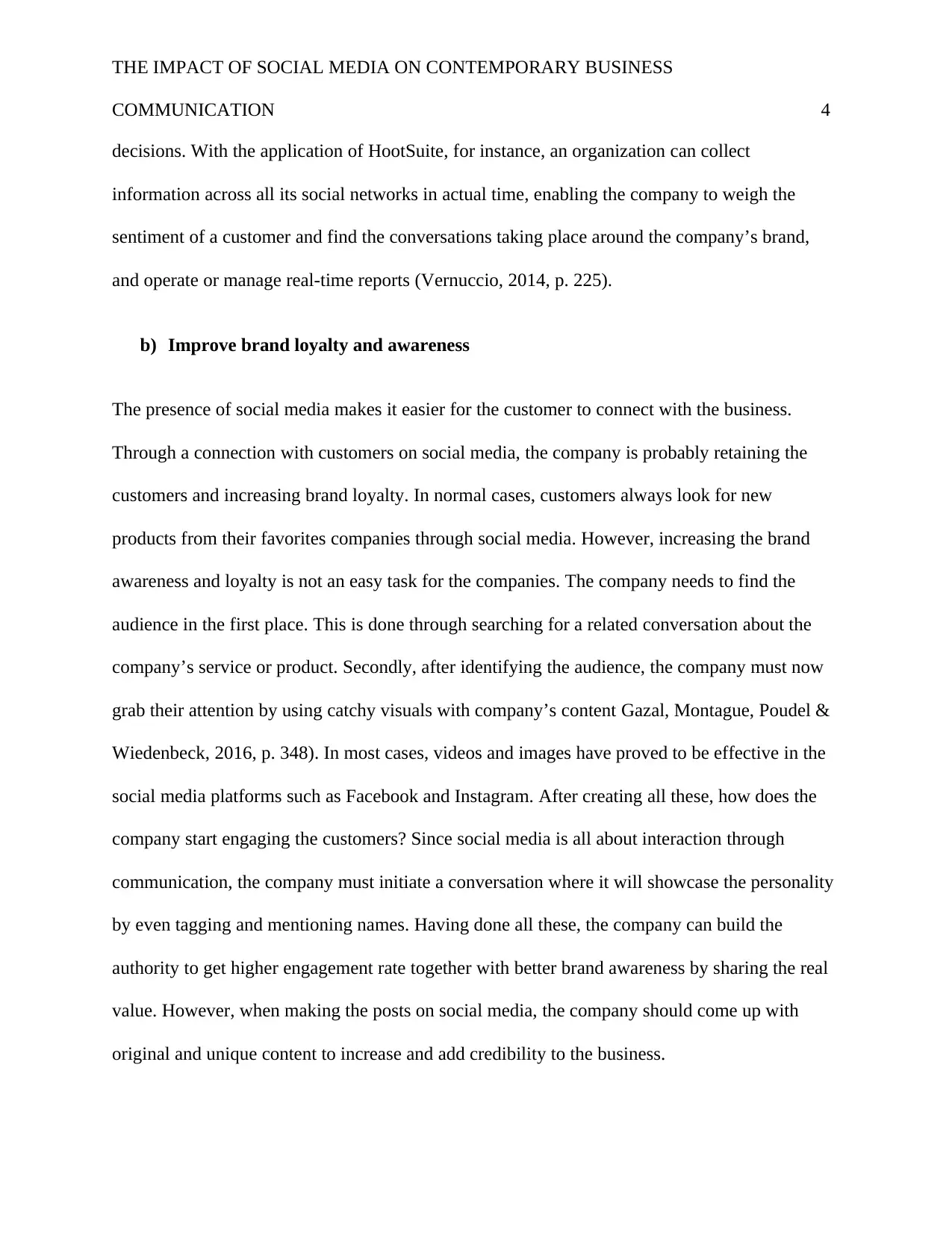
THE IMPACT OF SOCIAL MEDIA ON CONTEMPORARY BUSINESS
COMMUNICATION 4
decisions. With the application of HootSuite, for instance, an organization can collect
information across all its social networks in actual time, enabling the company to weigh the
sentiment of a customer and find the conversations taking place around the company’s brand,
and operate or manage real-time reports (Vernuccio, 2014, p. 225).
b) Improve brand loyalty and awareness
The presence of social media makes it easier for the customer to connect with the business.
Through a connection with customers on social media, the company is probably retaining the
customers and increasing brand loyalty. In normal cases, customers always look for new
products from their favorites companies through social media. However, increasing the brand
awareness and loyalty is not an easy task for the companies. The company needs to find the
audience in the first place. This is done through searching for a related conversation about the
company’s service or product. Secondly, after identifying the audience, the company must now
grab their attention by using catchy visuals with company’s content Gazal, Montague, Poudel &
Wiedenbeck, 2016, p. 348). In most cases, videos and images have proved to be effective in the
social media platforms such as Facebook and Instagram. After creating all these, how does the
company start engaging the customers? Since social media is all about interaction through
communication, the company must initiate a conversation where it will showcase the personality
by even tagging and mentioning names. Having done all these, the company can build the
authority to get higher engagement rate together with better brand awareness by sharing the real
value. However, when making the posts on social media, the company should come up with
original and unique content to increase and add credibility to the business.
COMMUNICATION 4
decisions. With the application of HootSuite, for instance, an organization can collect
information across all its social networks in actual time, enabling the company to weigh the
sentiment of a customer and find the conversations taking place around the company’s brand,
and operate or manage real-time reports (Vernuccio, 2014, p. 225).
b) Improve brand loyalty and awareness
The presence of social media makes it easier for the customer to connect with the business.
Through a connection with customers on social media, the company is probably retaining the
customers and increasing brand loyalty. In normal cases, customers always look for new
products from their favorites companies through social media. However, increasing the brand
awareness and loyalty is not an easy task for the companies. The company needs to find the
audience in the first place. This is done through searching for a related conversation about the
company’s service or product. Secondly, after identifying the audience, the company must now
grab their attention by using catchy visuals with company’s content Gazal, Montague, Poudel &
Wiedenbeck, 2016, p. 348). In most cases, videos and images have proved to be effective in the
social media platforms such as Facebook and Instagram. After creating all these, how does the
company start engaging the customers? Since social media is all about interaction through
communication, the company must initiate a conversation where it will showcase the personality
by even tagging and mentioning names. Having done all these, the company can build the
authority to get higher engagement rate together with better brand awareness by sharing the real
value. However, when making the posts on social media, the company should come up with
original and unique content to increase and add credibility to the business.
Paraphrase This Document
Need a fresh take? Get an instant paraphrase of this document with our AI Paraphraser
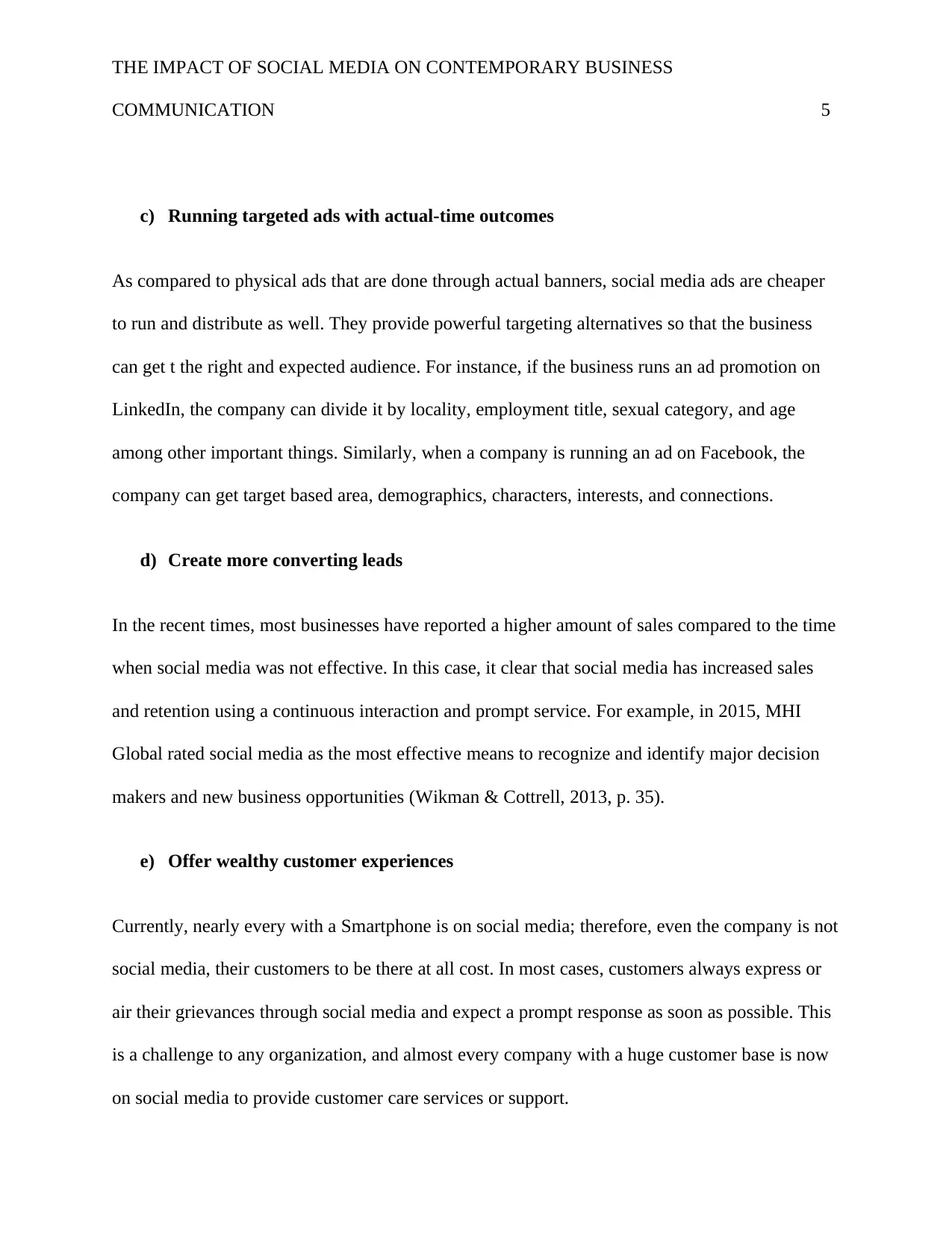
THE IMPACT OF SOCIAL MEDIA ON CONTEMPORARY BUSINESS
COMMUNICATION 5
c) Running targeted ads with actual-time outcomes
As compared to physical ads that are done through actual banners, social media ads are cheaper
to run and distribute as well. They provide powerful targeting alternatives so that the business
can get t the right and expected audience. For instance, if the business runs an ad promotion on
LinkedIn, the company can divide it by locality, employment title, sexual category, and age
among other important things. Similarly, when a company is running an ad on Facebook, the
company can get target based area, demographics, characters, interests, and connections.
d) Create more converting leads
In the recent times, most businesses have reported a higher amount of sales compared to the time
when social media was not effective. In this case, it clear that social media has increased sales
and retention using a continuous interaction and prompt service. For example, in 2015, MHI
Global rated social media as the most effective means to recognize and identify major decision
makers and new business opportunities (Wikman & Cottrell, 2013, p. 35).
e) Offer wealthy customer experiences
Currently, nearly every with a Smartphone is on social media; therefore, even the company is not
social media, their customers to be there at all cost. In most cases, customers always express or
air their grievances through social media and expect a prompt response as soon as possible. This
is a challenge to any organization, and almost every company with a huge customer base is now
on social media to provide customer care services or support.
COMMUNICATION 5
c) Running targeted ads with actual-time outcomes
As compared to physical ads that are done through actual banners, social media ads are cheaper
to run and distribute as well. They provide powerful targeting alternatives so that the business
can get t the right and expected audience. For instance, if the business runs an ad promotion on
LinkedIn, the company can divide it by locality, employment title, sexual category, and age
among other important things. Similarly, when a company is running an ad on Facebook, the
company can get target based area, demographics, characters, interests, and connections.
d) Create more converting leads
In the recent times, most businesses have reported a higher amount of sales compared to the time
when social media was not effective. In this case, it clear that social media has increased sales
and retention using a continuous interaction and prompt service. For example, in 2015, MHI
Global rated social media as the most effective means to recognize and identify major decision
makers and new business opportunities (Wikman & Cottrell, 2013, p. 35).
e) Offer wealthy customer experiences
Currently, nearly every with a Smartphone is on social media; therefore, even the company is not
social media, their customers to be there at all cost. In most cases, customers always express or
air their grievances through social media and expect a prompt response as soon as possible. This
is a challenge to any organization, and almost every company with a huge customer base is now
on social media to provide customer care services or support.
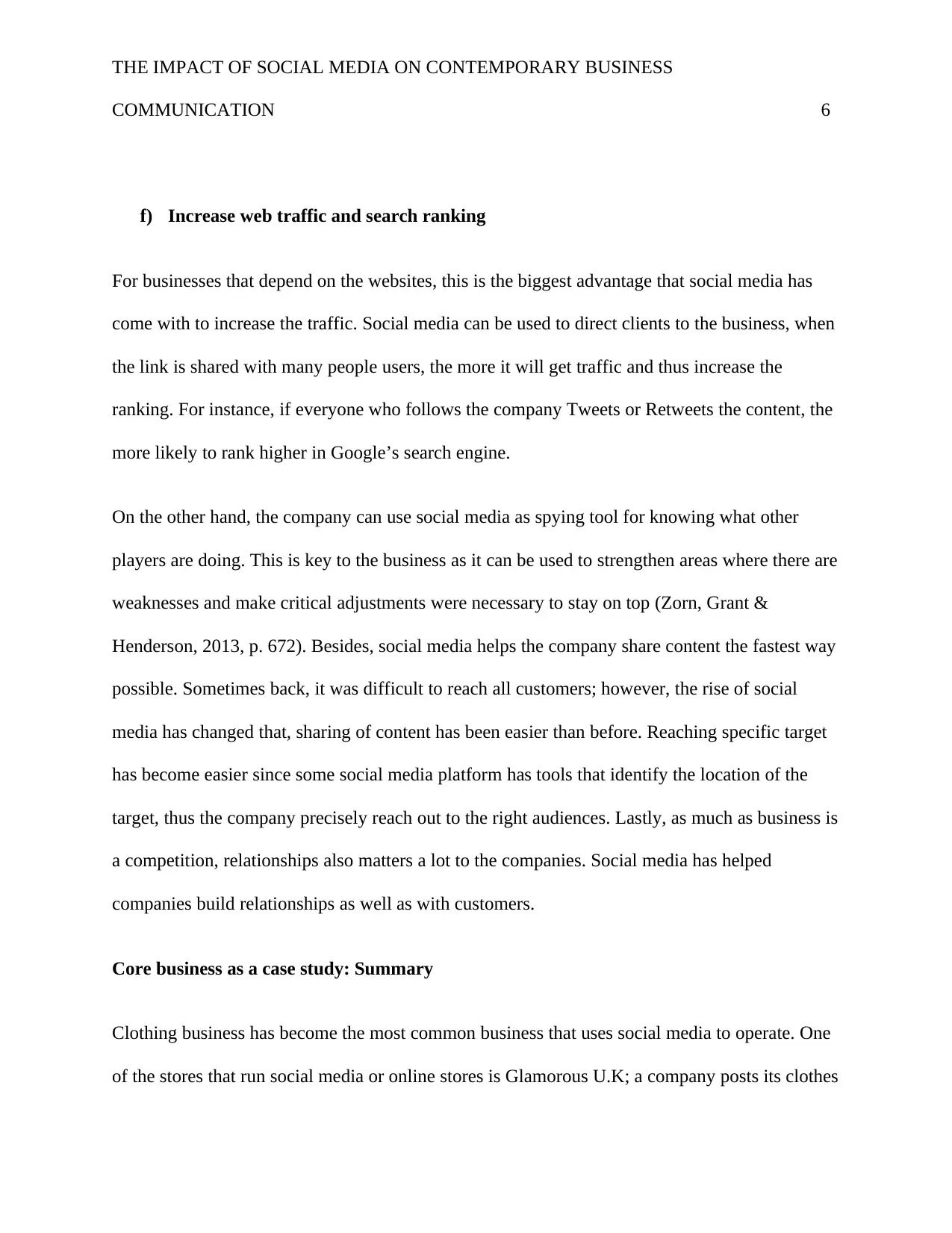
THE IMPACT OF SOCIAL MEDIA ON CONTEMPORARY BUSINESS
COMMUNICATION 6
f) Increase web traffic and search ranking
For businesses that depend on the websites, this is the biggest advantage that social media has
come with to increase the traffic. Social media can be used to direct clients to the business, when
the link is shared with many people users, the more it will get traffic and thus increase the
ranking. For instance, if everyone who follows the company Tweets or Retweets the content, the
more likely to rank higher in Google’s search engine.
On the other hand, the company can use social media as spying tool for knowing what other
players are doing. This is key to the business as it can be used to strengthen areas where there are
weaknesses and make critical adjustments were necessary to stay on top (Zorn, Grant &
Henderson, 2013, p. 672). Besides, social media helps the company share content the fastest way
possible. Sometimes back, it was difficult to reach all customers; however, the rise of social
media has changed that, sharing of content has been easier than before. Reaching specific target
has become easier since some social media platform has tools that identify the location of the
target, thus the company precisely reach out to the right audiences. Lastly, as much as business is
a competition, relationships also matters a lot to the companies. Social media has helped
companies build relationships as well as with customers.
Core business as a case study: Summary
Clothing business has become the most common business that uses social media to operate. One
of the stores that run social media or online stores is Glamorous U.K; a company posts its clothes
COMMUNICATION 6
f) Increase web traffic and search ranking
For businesses that depend on the websites, this is the biggest advantage that social media has
come with to increase the traffic. Social media can be used to direct clients to the business, when
the link is shared with many people users, the more it will get traffic and thus increase the
ranking. For instance, if everyone who follows the company Tweets or Retweets the content, the
more likely to rank higher in Google’s search engine.
On the other hand, the company can use social media as spying tool for knowing what other
players are doing. This is key to the business as it can be used to strengthen areas where there are
weaknesses and make critical adjustments were necessary to stay on top (Zorn, Grant &
Henderson, 2013, p. 672). Besides, social media helps the company share content the fastest way
possible. Sometimes back, it was difficult to reach all customers; however, the rise of social
media has changed that, sharing of content has been easier than before. Reaching specific target
has become easier since some social media platform has tools that identify the location of the
target, thus the company precisely reach out to the right audiences. Lastly, as much as business is
a competition, relationships also matters a lot to the companies. Social media has helped
companies build relationships as well as with customers.
Core business as a case study: Summary
Clothing business has become the most common business that uses social media to operate. One
of the stores that run social media or online stores is Glamorous U.K; a company posts its clothes
⊘ This is a preview!⊘
Do you want full access?
Subscribe today to unlock all pages.

Trusted by 1+ million students worldwide
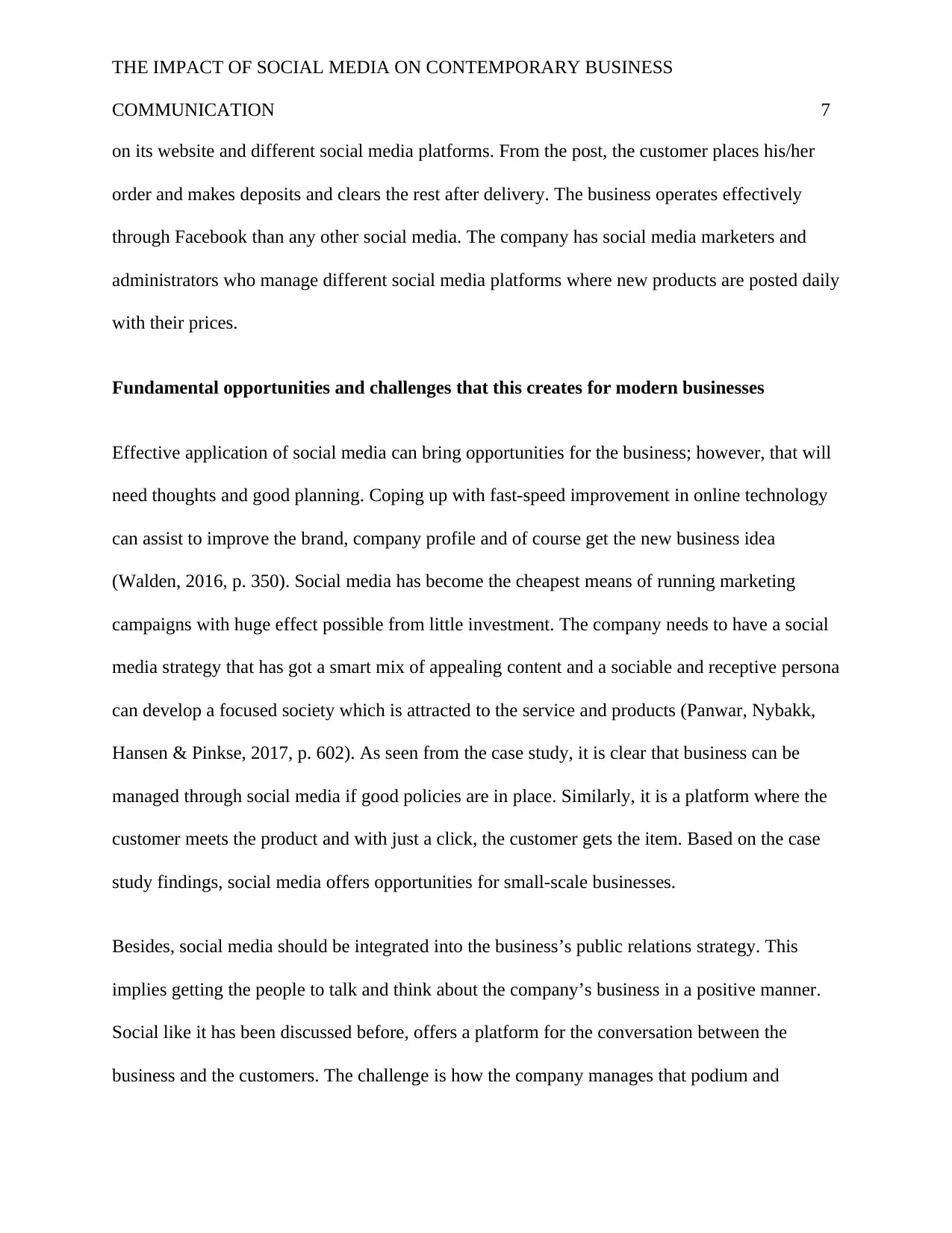
THE IMPACT OF SOCIAL MEDIA ON CONTEMPORARY BUSINESS
COMMUNICATION 7
on its website and different social media platforms. From the post, the customer places his/her
order and makes deposits and clears the rest after delivery. The business operates effectively
through Facebook than any other social media. The company has social media marketers and
administrators who manage different social media platforms where new products are posted daily
with their prices.
Fundamental opportunities and challenges that this creates for modern businesses
Effective application of social media can bring opportunities for the business; however, that will
need thoughts and good planning. Coping up with fast-speed improvement in online technology
can assist to improve the brand, company profile and of course get the new business idea
(Walden, 2016, p. 350). Social media has become the cheapest means of running marketing
campaigns with huge effect possible from little investment. The company needs to have a social
media strategy that has got a smart mix of appealing content and a sociable and receptive persona
can develop a focused society which is attracted to the service and products (Panwar, Nybakk,
Hansen & Pinkse, 2017, p. 602). As seen from the case study, it is clear that business can be
managed through social media if good policies are in place. Similarly, it is a platform where the
customer meets the product and with just a click, the customer gets the item. Based on the case
study findings, social media offers opportunities for small-scale businesses.
Besides, social media should be integrated into the business’s public relations strategy. This
implies getting the people to talk and think about the company’s business in a positive manner.
Social like it has been discussed before, offers a platform for the conversation between the
business and the customers. The challenge is how the company manages that podium and
COMMUNICATION 7
on its website and different social media platforms. From the post, the customer places his/her
order and makes deposits and clears the rest after delivery. The business operates effectively
through Facebook than any other social media. The company has social media marketers and
administrators who manage different social media platforms where new products are posted daily
with their prices.
Fundamental opportunities and challenges that this creates for modern businesses
Effective application of social media can bring opportunities for the business; however, that will
need thoughts and good planning. Coping up with fast-speed improvement in online technology
can assist to improve the brand, company profile and of course get the new business idea
(Walden, 2016, p. 350). Social media has become the cheapest means of running marketing
campaigns with huge effect possible from little investment. The company needs to have a social
media strategy that has got a smart mix of appealing content and a sociable and receptive persona
can develop a focused society which is attracted to the service and products (Panwar, Nybakk,
Hansen & Pinkse, 2017, p. 602). As seen from the case study, it is clear that business can be
managed through social media if good policies are in place. Similarly, it is a platform where the
customer meets the product and with just a click, the customer gets the item. Based on the case
study findings, social media offers opportunities for small-scale businesses.
Besides, social media should be integrated into the business’s public relations strategy. This
implies getting the people to talk and think about the company’s business in a positive manner.
Social like it has been discussed before, offers a platform for the conversation between the
business and the customers. The challenge is how the company manages that podium and
Paraphrase This Document
Need a fresh take? Get an instant paraphrase of this document with our AI Paraphraser
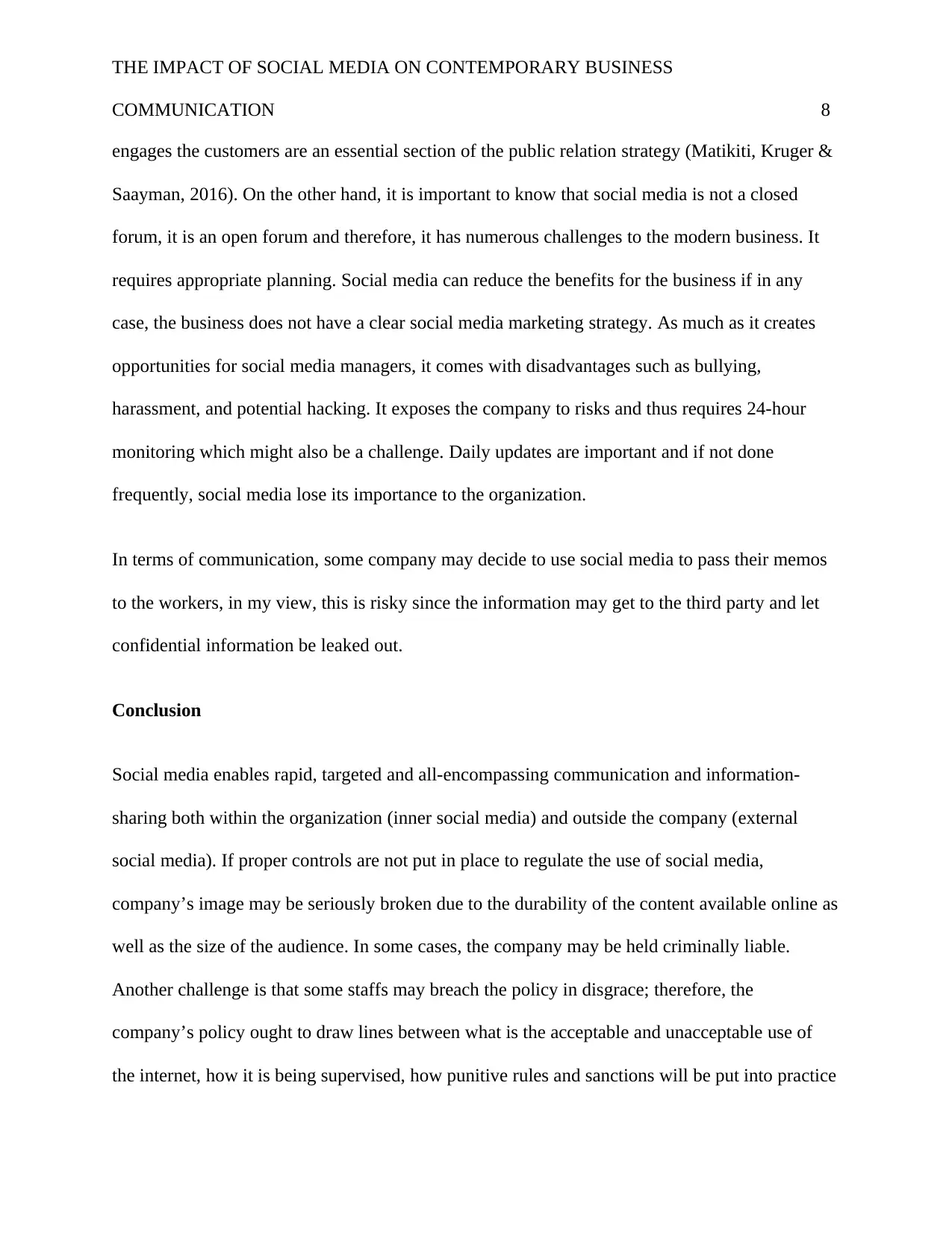
THE IMPACT OF SOCIAL MEDIA ON CONTEMPORARY BUSINESS
COMMUNICATION 8
engages the customers are an essential section of the public relation strategy (Matikiti, Kruger &
Saayman, 2016). On the other hand, it is important to know that social media is not a closed
forum, it is an open forum and therefore, it has numerous challenges to the modern business. It
requires appropriate planning. Social media can reduce the benefits for the business if in any
case, the business does not have a clear social media marketing strategy. As much as it creates
opportunities for social media managers, it comes with disadvantages such as bullying,
harassment, and potential hacking. It exposes the company to risks and thus requires 24-hour
monitoring which might also be a challenge. Daily updates are important and if not done
frequently, social media lose its importance to the organization.
In terms of communication, some company may decide to use social media to pass their memos
to the workers, in my view, this is risky since the information may get to the third party and let
confidential information be leaked out.
Conclusion
Social media enables rapid, targeted and all-encompassing communication and information-
sharing both within the organization (inner social media) and outside the company (external
social media). If proper controls are not put in place to regulate the use of social media,
company’s image may be seriously broken due to the durability of the content available online as
well as the size of the audience. In some cases, the company may be held criminally liable.
Another challenge is that some staffs may breach the policy in disgrace; therefore, the
company’s policy ought to draw lines between what is the acceptable and unacceptable use of
the internet, how it is being supervised, how punitive rules and sanctions will be put into practice
COMMUNICATION 8
engages the customers are an essential section of the public relation strategy (Matikiti, Kruger &
Saayman, 2016). On the other hand, it is important to know that social media is not a closed
forum, it is an open forum and therefore, it has numerous challenges to the modern business. It
requires appropriate planning. Social media can reduce the benefits for the business if in any
case, the business does not have a clear social media marketing strategy. As much as it creates
opportunities for social media managers, it comes with disadvantages such as bullying,
harassment, and potential hacking. It exposes the company to risks and thus requires 24-hour
monitoring which might also be a challenge. Daily updates are important and if not done
frequently, social media lose its importance to the organization.
In terms of communication, some company may decide to use social media to pass their memos
to the workers, in my view, this is risky since the information may get to the third party and let
confidential information be leaked out.
Conclusion
Social media enables rapid, targeted and all-encompassing communication and information-
sharing both within the organization (inner social media) and outside the company (external
social media). If proper controls are not put in place to regulate the use of social media,
company’s image may be seriously broken due to the durability of the content available online as
well as the size of the audience. In some cases, the company may be held criminally liable.
Another challenge is that some staffs may breach the policy in disgrace; therefore, the
company’s policy ought to draw lines between what is the acceptable and unacceptable use of
the internet, how it is being supervised, how punitive rules and sanctions will be put into practice
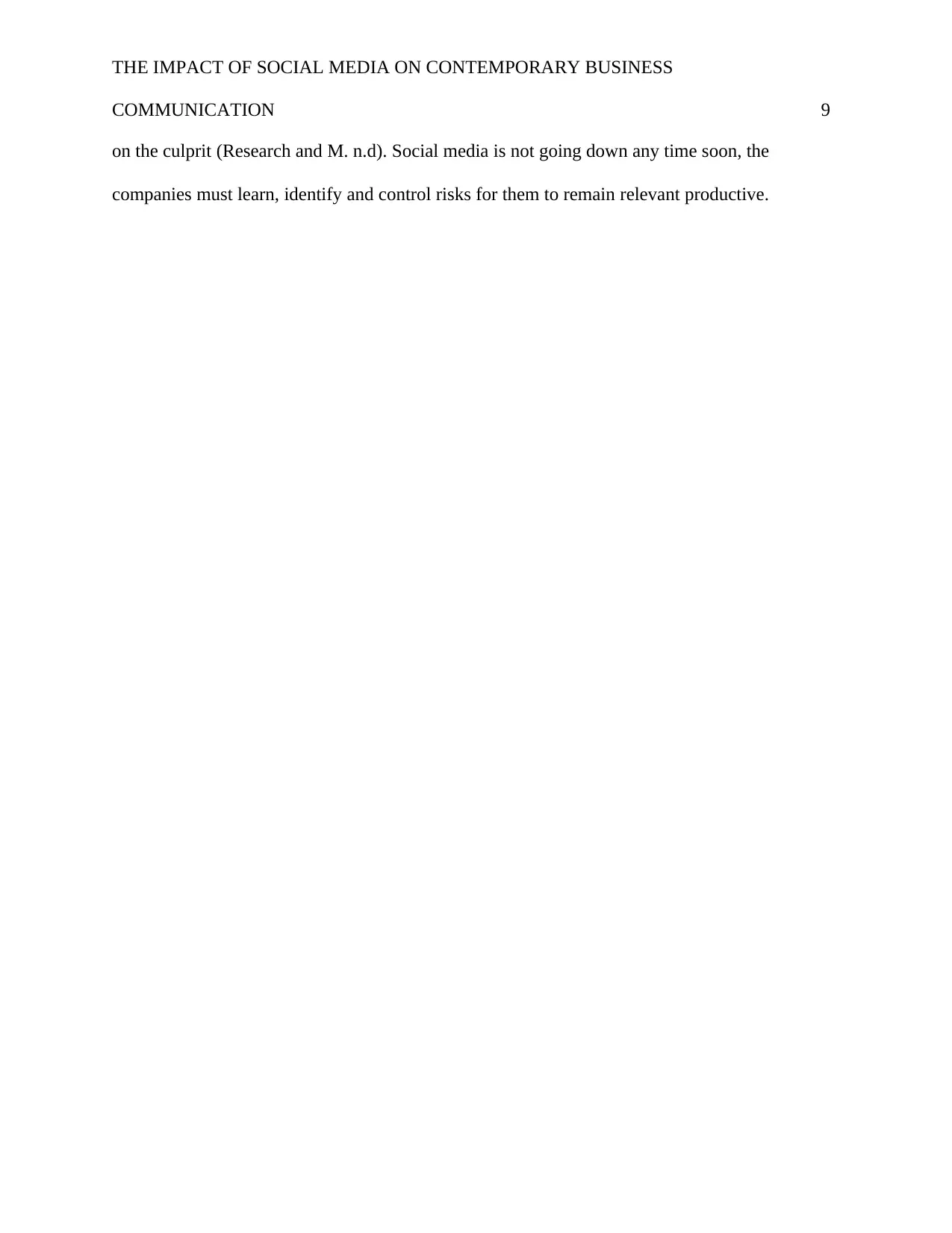
THE IMPACT OF SOCIAL MEDIA ON CONTEMPORARY BUSINESS
COMMUNICATION 9
on the culprit (Research and M. n.d). Social media is not going down any time soon, the
companies must learn, identify and control risks for them to remain relevant productive.
COMMUNICATION 9
on the culprit (Research and M. n.d). Social media is not going down any time soon, the
companies must learn, identify and control risks for them to remain relevant productive.
⊘ This is a preview!⊘
Do you want full access?
Subscribe today to unlock all pages.

Trusted by 1+ million students worldwide
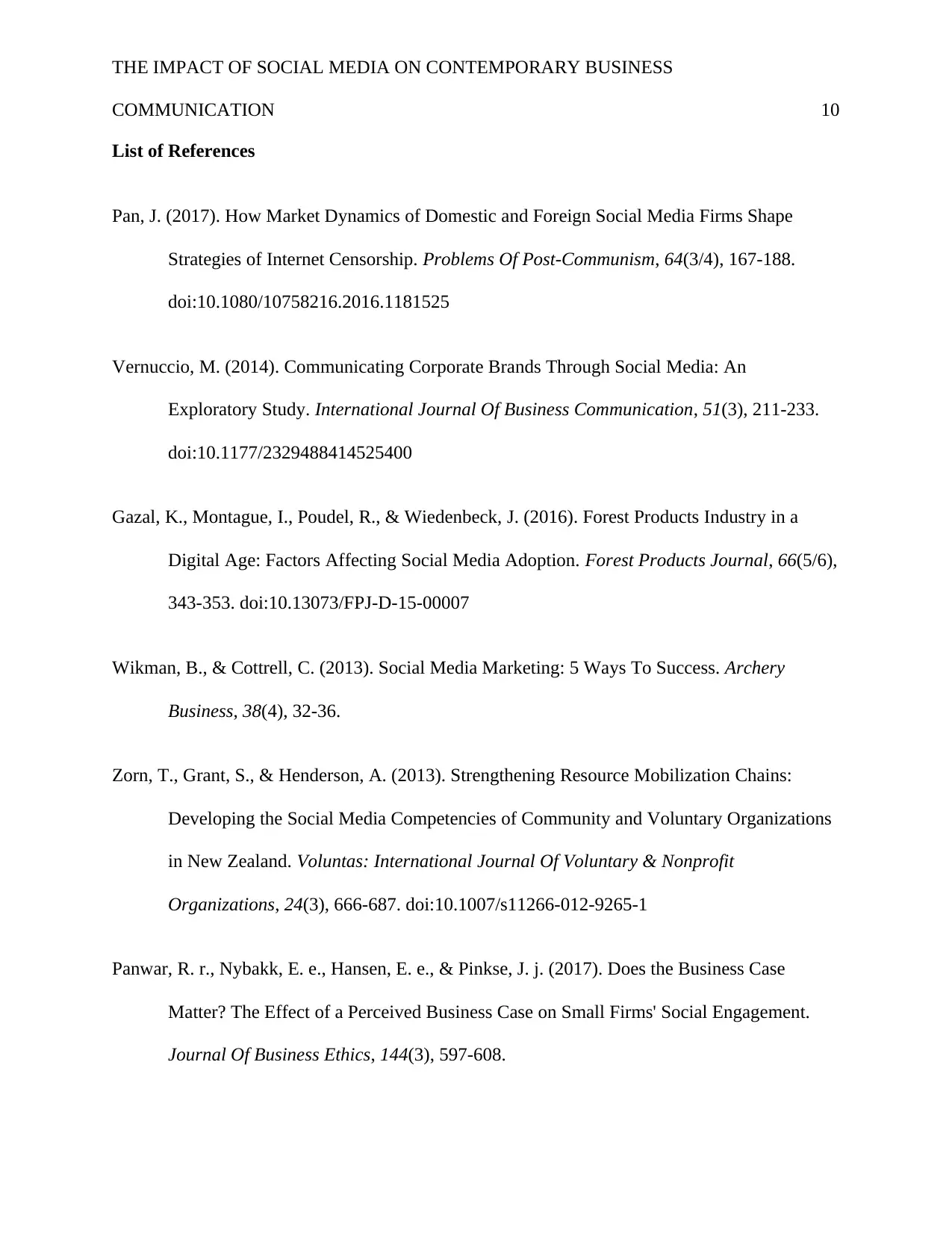
THE IMPACT OF SOCIAL MEDIA ON CONTEMPORARY BUSINESS
COMMUNICATION 10
List of References
Pan, J. (2017). How Market Dynamics of Domestic and Foreign Social Media Firms Shape
Strategies of Internet Censorship. Problems Of Post-Communism, 64(3/4), 167-188.
doi:10.1080/10758216.2016.1181525
Vernuccio, M. (2014). Communicating Corporate Brands Through Social Media: An
Exploratory Study. International Journal Of Business Communication, 51(3), 211-233.
doi:10.1177/2329488414525400
Gazal, K., Montague, I., Poudel, R., & Wiedenbeck, J. (2016). Forest Products Industry in a
Digital Age: Factors Affecting Social Media Adoption. Forest Products Journal, 66(5/6),
343-353. doi:10.13073/FPJ-D-15-00007
Wikman, B., & Cottrell, C. (2013). Social Media Marketing: 5 Ways To Success. Archery
Business, 38(4), 32-36.
Zorn, T., Grant, S., & Henderson, A. (2013). Strengthening Resource Mobilization Chains:
Developing the Social Media Competencies of Community and Voluntary Organizations
in New Zealand. Voluntas: International Journal Of Voluntary & Nonprofit
Organizations, 24(3), 666-687. doi:10.1007/s11266-012-9265-1
Panwar, R. r., Nybakk, E. e., Hansen, E. e., & Pinkse, J. j. (2017). Does the Business Case
Matter? The Effect of a Perceived Business Case on Small Firms' Social Engagement.
Journal Of Business Ethics, 144(3), 597-608.
COMMUNICATION 10
List of References
Pan, J. (2017). How Market Dynamics of Domestic and Foreign Social Media Firms Shape
Strategies of Internet Censorship. Problems Of Post-Communism, 64(3/4), 167-188.
doi:10.1080/10758216.2016.1181525
Vernuccio, M. (2014). Communicating Corporate Brands Through Social Media: An
Exploratory Study. International Journal Of Business Communication, 51(3), 211-233.
doi:10.1177/2329488414525400
Gazal, K., Montague, I., Poudel, R., & Wiedenbeck, J. (2016). Forest Products Industry in a
Digital Age: Factors Affecting Social Media Adoption. Forest Products Journal, 66(5/6),
343-353. doi:10.13073/FPJ-D-15-00007
Wikman, B., & Cottrell, C. (2013). Social Media Marketing: 5 Ways To Success. Archery
Business, 38(4), 32-36.
Zorn, T., Grant, S., & Henderson, A. (2013). Strengthening Resource Mobilization Chains:
Developing the Social Media Competencies of Community and Voluntary Organizations
in New Zealand. Voluntas: International Journal Of Voluntary & Nonprofit
Organizations, 24(3), 666-687. doi:10.1007/s11266-012-9265-1
Panwar, R. r., Nybakk, E. e., Hansen, E. e., & Pinkse, J. j. (2017). Does the Business Case
Matter? The Effect of a Perceived Business Case on Small Firms' Social Engagement.
Journal Of Business Ethics, 144(3), 597-608.
Paraphrase This Document
Need a fresh take? Get an instant paraphrase of this document with our AI Paraphraser
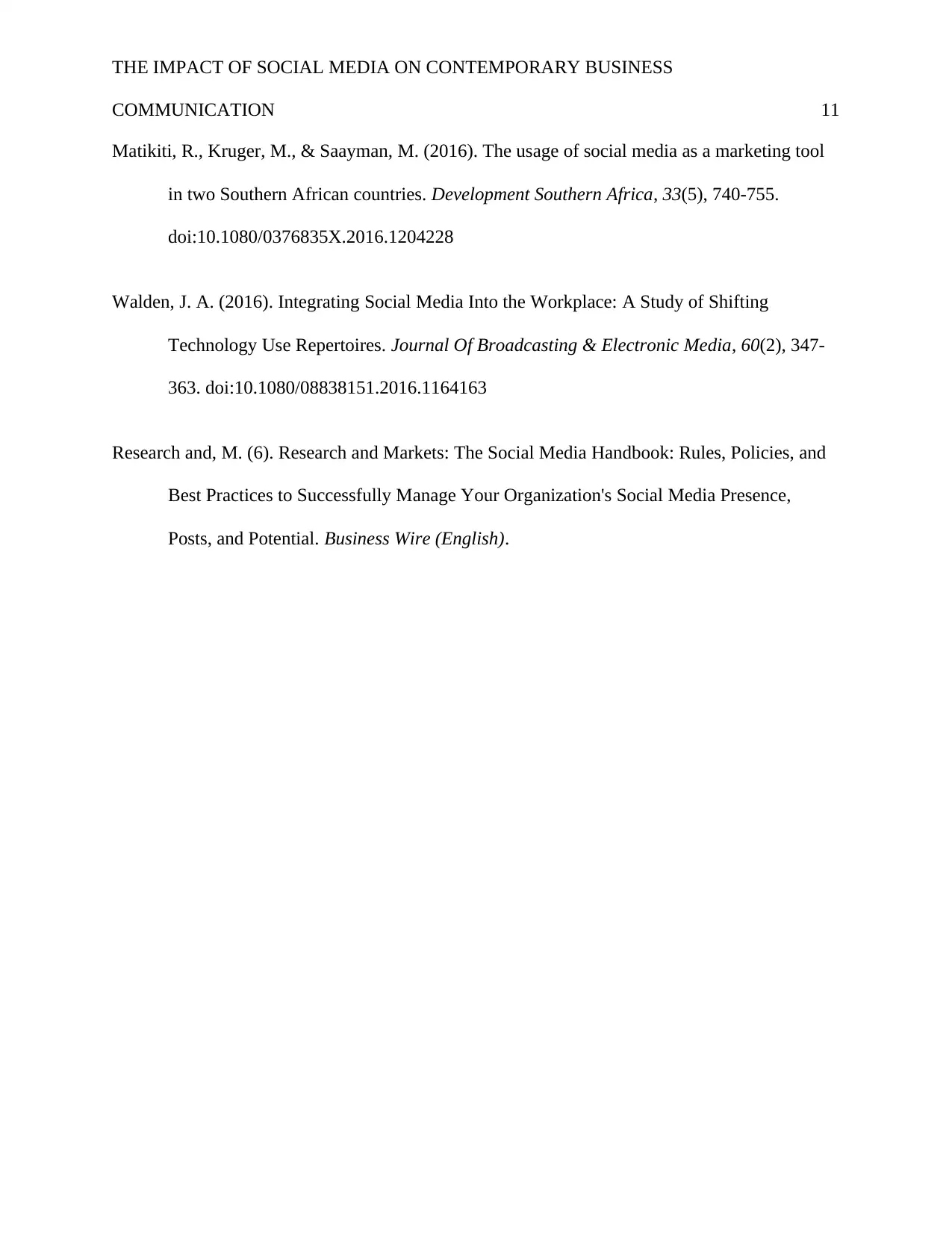
THE IMPACT OF SOCIAL MEDIA ON CONTEMPORARY BUSINESS
COMMUNICATION 11
Matikiti, R., Kruger, M., & Saayman, M. (2016). The usage of social media as a marketing tool
in two Southern African countries. Development Southern Africa, 33(5), 740-755.
doi:10.1080/0376835X.2016.1204228
Walden, J. A. (2016). Integrating Social Media Into the Workplace: A Study of Shifting
Technology Use Repertoires. Journal Of Broadcasting & Electronic Media, 60(2), 347-
363. doi:10.1080/08838151.2016.1164163
Research and, M. (6). Research and Markets: The Social Media Handbook: Rules, Policies, and
Best Practices to Successfully Manage Your Organization's Social Media Presence,
Posts, and Potential. Business Wire (English).
COMMUNICATION 11
Matikiti, R., Kruger, M., & Saayman, M. (2016). The usage of social media as a marketing tool
in two Southern African countries. Development Southern Africa, 33(5), 740-755.
doi:10.1080/0376835X.2016.1204228
Walden, J. A. (2016). Integrating Social Media Into the Workplace: A Study of Shifting
Technology Use Repertoires. Journal Of Broadcasting & Electronic Media, 60(2), 347-
363. doi:10.1080/08838151.2016.1164163
Research and, M. (6). Research and Markets: The Social Media Handbook: Rules, Policies, and
Best Practices to Successfully Manage Your Organization's Social Media Presence,
Posts, and Potential. Business Wire (English).
1 out of 11
Related Documents
Your All-in-One AI-Powered Toolkit for Academic Success.
+13062052269
info@desklib.com
Available 24*7 on WhatsApp / Email
![[object Object]](/_next/static/media/star-bottom.7253800d.svg)
Unlock your academic potential
Copyright © 2020–2025 A2Z Services. All Rights Reserved. Developed and managed by ZUCOL.





